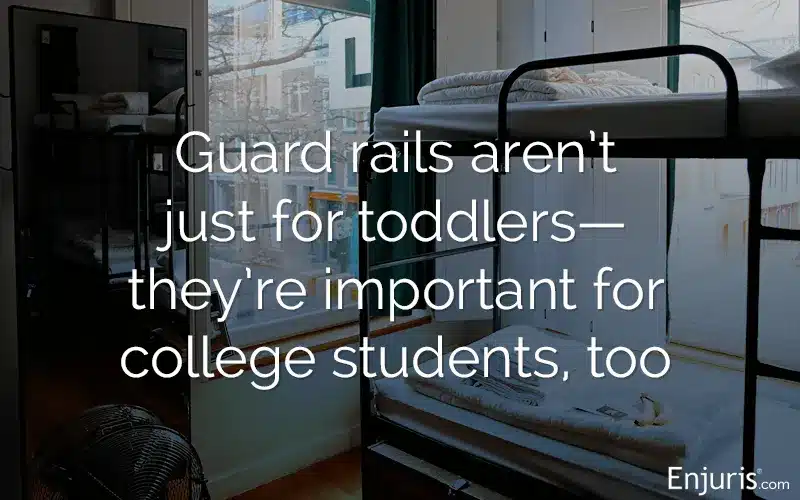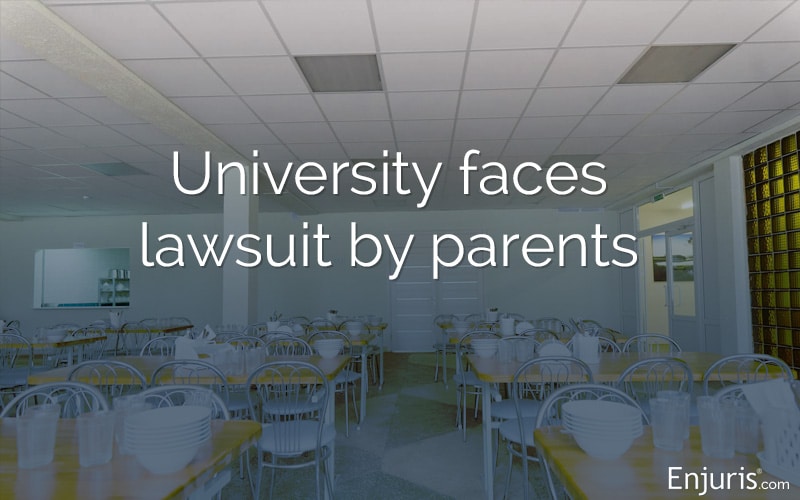
Serious injuries have happened to college students from falling from lofted beds
Your bed should be your safe space, but if it’s lofted or bunked, as is common in college dorms, a guardrail is necessary. Several recent serious injuries have happened to university students who fell from their beds that didn’t have guardrails.
Parents who send their children off to college worry about a lot of things. Kids being away from home for the first time can be stressful for parents and students alike. New surroundings, new people, and having to take care of themselves and handle things they never dealt with while living under their parents’ roof can be tricky.
But one thing most parents might not think to worry about is whether or not their child’s bed has a bed rail. Many people use bed rails for toddlers, but once their children are out of that phase, they think bed rails are a thing of the past.
Loft bed tragedy
Clark Jacobs lived in the Kappa Sigma fraternity house at Georgia Tech in 2015. The 20-year-old was working on a degree in mechanical engineering and enjoying the full college experience.
But one night, life as he knew it was over. Jacobs was sleeping in his loft bed when he fell seven feet and fractured his skull on the linoleum floor. He suffered a stroke and had to endure two emergency surgeries. He spent the next several months in the hospital.
Clark had to relearn everything, including how to walk, talk and eat. He wasn’t able to return to campus until 2016. He has since earned his degree and recovered from the injury, but his family wants to raise awareness so no other student or family ever endures this type of injury again.
Loft bed/bunk bed injury statistics
Advocacy group Rail Against the Danger says there are about 71,000 loft or bunk bed-related injuries each year among children and young adults up to age 21. There were twice as many more injuries among young adults ages 18-21 than among children under 16. Three-quarters of bunk bed-related injuries were due to falls. The group estimates that about 450 people die each year from falling out of bed.
Bunk beds are typical in college dorms, but lots of families have them in their homes, too. Most people don’t think their child’s bed is dangerous after the child is old enough to sleep on a regular bed and out of a toddler bed or crib.
Dorm room beds are often narrower than a typical twin, which might be what your child is accustomed to at home. And, while drinking or drug use could certainly contribute to the likelihood that a student would fall out of bed, it can happen for other reasons, too. Students might be very tired after long days and study-fueled nights. They could be awakened in the night by a building alarm, other loud noise, or a roommate and temporarily forget that they need to climb down from their bed. And, accidents happen. Plain and simple.
Federal laws for bunk bed guardrails
Federal law sets forth requirements for bunk bed guardrails. A bunk bed is, “a bed with the bottom of its mattress foundation more than 30 inches above the floor.”
Some of the requirements are intended to prevent falls, and others are intended to prevent entrapment.
The Consumer Product Safety Commission (CPSC) sets forth bunk bed requirements that include:
- An upper bunk bed must have at least one rail on each side. The lower bunk does not need to have rails.
- The distance between either end of the guardrail and the end of the nearest bed on the side away from the wall cannot be greater than 15 inches.
- The guardrail must be attached with fasteners that are released before the rails are removed or the rail must be designed to move in two ore more different directions to release it.
- The top of the guardrail must be at least five inches above the top of the mattress.
There are some other guidelines to prevent entrapment, but that is more of a risk for younger children than college students.
Liability for college dorm bed injuries
Elizabeth Davis began her freshman year at Valdosta State University in Georgia in 2016. She lived in a dorm room with a lofted bed configuration. Elizabeth requested a lower bed but the university had not fulfilled her request.
One night in October, Elizabeth went to a party and had a few beers. She felt tipsy and returned to her dorm, where she got into her bed and went to sleep. She had apparently fallen out of her loft bed, because when she awoke, she was on the floor. She’d sustained serious injuries, endured surgery and was treated in the hospital’s intensive care unit.
Elizabeth had to withdraw from school in the spring semester that year because the concussion she’d suffered from the fall affected her academic performance and ability to concentrate.
She filed a legal complaint against Valdosta, alleging that the school was negligent in failing to install bed rails, and that’s what caused her injury. The lawsuit claimed that Valdosta knew about the specific risk of falling out of bed because of incidents like what happened to Clark Jacobs.
However, Davis’ lawsuit was not successful. The court determined that since the loft bed was an “open and obvious” condition, the school was not liable. One of the elements of premises liability law in Georgia is that the plaintiff (injured person) must have lacked knowledge of the hazard, despite exercising ordinary care. Clearly, Elizabeth knew that her bed did not have a guardrail.
The court said that she could not recover damages because the hazard was “open and obvious” and she could have avoided the negligence of not having a bedrail by exercising ordinary care. Even though the school had knowledge that there was a lofted bed with no guardrail, Elizabeth had equal knowledge that her bed was unprotected. She therefore did not recover damages.
However, in a public policy context, a college or university has a duty to take reasonable measures to protect students from harm. The school should take steps to avoid harm if it is aware of the hazard and should have responded to her request for a guardrail.
If you’re a parent sending your child to a college or university, or even to summer camp or any overnight program, it’s worth checking ahead of time to ensure that any lofted beds are equipped with safety guardrails. Your child might be embarrassed or annoyed, but they’ll survive. The alternative is far worse.
Parents Sue University For Student Death from Allergy
A student died after eating what he believed to be chicken in the university dining hall… but it was contaminated with fish. Now his parents are suing.

